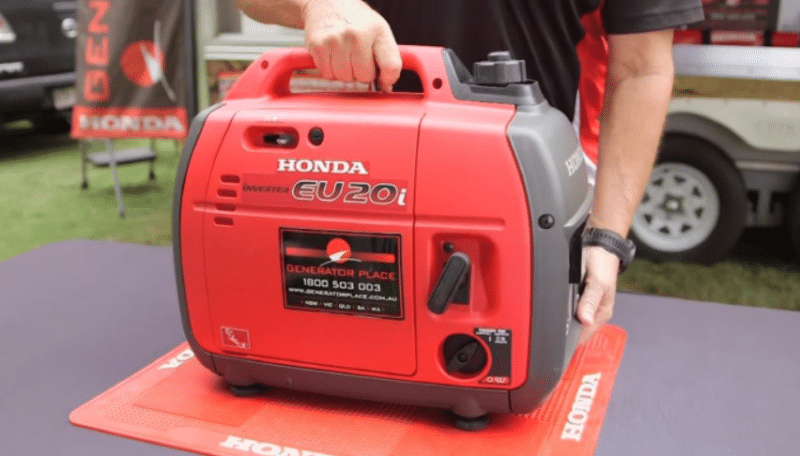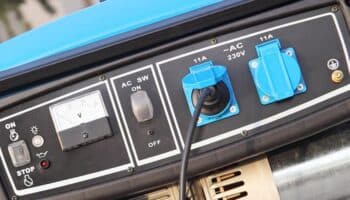Stuck trying to figure out how to quiet your portable generator?
Your portable generator can be a lifesaver on the road. Not only does it keep the fridge cool or power your kettle, but it can also come to the rescue when your car battery goes flat.
But, I’m sure you’ll agree that its noise can be super annoying. Luckily, you’ve come to the right place to fix this issue.
You can quiet a portable generator by placing it further away, changing the surface or muffler, or adjusting the position of the exhaust pipes. You can also reduce the vibration in the engine housing, use a water bucket, or soundproof your tent.
Keep reading to learn more about these and more tips!

Why Is A Portable Generator Noisy?
Generators are basically engines that combust fuel to generate power – and this is a noisy process. When you add an exhaust pipe for fumes, you get a channel for even more noise.
Design factors also add to the problem. Portable generators are small and lightweight. This means they have thin casings that provide little insulation against noise and vibration (unlike car engines, which are covered in steel and fitted with mufflers).
Having said that, some high-end brands are equipped with inbuilt soundproofing and rubber feet, which can significantly reduce noise and vibration.
However, if the generator is large and powerful, noise is going to be inevitable. In general, the more power you have, the more noise you get!
Lastly, a generator can also be noisy because it’s old or faulty. If you find that the noise is louder than usual, or your generator is starting to smoke, take it to a professional for an inspection or service. Like your car or lawnmower, it should be serviced regularly!
12 Tips for Making a Portable Generator Quieter
There are plenty of ways to quieten your generator. Some can be implemented quickly, while others require some DIY handiwork.
We recommend going through these tips in order. If the noise is still unbearable after trying the first method, try out the next one and keep going until you’re happy.
The truth is, every generator is different, and tolerance levels vary. If you attempted some of these solutions in the past and they didn’t work, try a different one. Alternatively, try several methods at once. If you’re still unsuccessful, go straight to Tip #11 – or opt for a resort-style holiday!
#1 Place it Further Away
This may seem like a no-brainer, but you’d be surprised how many people keep their generator within a few feet of camp.
When you put your generator further away, you’re creating a buffer against sound, particularly if there are trees or other natural barriers in the way.
The best way to do this is to get a long extension cord. About seven meters should do it, but you can make it longer if there’s a secure spot away from water, campers, or curious children. The more isolated you are, the further you can go!
However, you should remember that a long extension cord can reduce power. A 10-meter cord could result in a drop of 2–3 volts, while a 20-meter cord could result in a drop of 5–6 volts. Keep this in mind when you’re powering your appliances or devices.
#2 Change the Surface
The surface you use for your generator can either dampen or amplify the noise.
Try to avoid concrete, wood, or other hard surfaces. Instead, opt for a flat expanse of dirt or grass, and make sure that the unit is stable and grounded. If it isn’t, you may get vibrations that increase noise.
If you need to enhance stability and avoid vibration on any of these surfaces, consider using rubber feet or an anti-vibration mat.
Don’t use materials like plastic or blankets. Generators can create heat, so you need a material that won’t melt, burn, or deteriorate.

#3 Adjust the Position of the Exhaust Pipes
If you’re still wondering how to quiet your portable generator, you might want to adjust the position of the exhaust pipes.
These are usually horizontal, which tends to siphon the fumes and noise toward you. By turning them up, you’ll be directing the sound away from your campsite and allowing it to dissipate in the air (just make sure it’s not towards someone else’s campsite).
But remember, this method only reduces the noise from the exhaust pipe, not the engine itself. As a result, we recommend combining it with one of the other tips on this list.
#4 Reduce Vibration in the Engine Housing
If the noise coming from your generator is mostly vibration, check the screws that attach the engine to the frame. If they’re loose, tighten them with a screwdriver.
There should also be rubber washers under the screws to dampen the noise and reduce vibration. If they look worn or thin, add new (and thicker) washers to increase shock absorbency.
#5 Fit a Silencer or Muffler
Generator silencers are similar to those used in car engines – they reduce the noise you get from combustion.
If you don’t already have one on your generator, there are three ways you can add a muffler to your engine exhaust.
You can fit a reactive silencer to reduce low-level noise, a fiberglass silencer to absorb high-frequency noise, or a combination silencer to reduce both.
However, unless you’ve tinkered around with engines before, it’s best to leave this job to a mechanic. A poorly fitted silencer could block the exhaust and damage your generator.
#6 Change the Muffler
If you’re still trying to quiet your portable generator, you might have a muffler that’s too small or no longer performing its duty.
That’s where a new car or motorcycle muffler can come in handy. These mufflers are generally larger and can reduce the sound levels by 10–15 decibels.
But before you go out and buy one, seek advice from a mechanic or technician to make sure it’s suitable for your generator. Mufflers need to be bent and welded to fit properly.
On the other hand, if you have some experience with engines, the following video will provide instructions on how to fit a car muffler into your generator exhaust.
#7 Use Sound Deflectors
If you’ve got some plywood boards lying around the garage, use them to quiet your portable generator.
Make sure they’re about 4 × 3 feet (0.91 m) and free of dust. Place them around the generator at an angle to provide an acoustic barrier, leaving a gap for the exhaust outlet.
You’ll be surprised by how quickly this can reduce the volume output. It may not be an attractive option, but it’s quick and cheap if you’ve got the materials at hand.
The following video shows you how a generator can drop 10 decibels with this simple method.
#8 Cover it With a Soundproof Box
If you don’t want to fuss around with loose plywood boards to quiet your portable generator, you can buy a soundproof box, also known as a baffle box.
These can be found in different sizes online or at selected home improvement centers.
For those who want to save money and make their own soundproof box, here are some quick steps you can follow.
What You Need:
- Medium Density Fiberboard (MDF) or soundboard sheets
- Mass Loaded Vinyl (MLV) sheet
- Closed-cell vinyl or foam matting
- acoustic calk
- nails or screws
- metal venting ducts
- handle (optional)
- insect-proof mesh (optional)
Once you’ve got the materials, you’ll need to:
- Take measurements: Start by measuring the size of your generator and include about three inches on each side to allow for insulation and ventilation.
- Cut the wood: Using these measurements, cut five sheets of Medium Density Fiberboard (MDF) or soundboard using a table saw.
- Make ventilation holes: Measure the size of your ventilation ducts and exhaust and mark these on your wood. Cut these out.
- Add insulation: Cut out five sheets of Mass Loaded Vinyl (MLV) to fit each side of the box. This will further block sound. Glue these on all four sides. Run some acoustic caulk around the edges to seal gaps and seams.
- Add a second layer of insulation: Cut five sheets of closed-cell vinyl or foam matting and glue them to the layer of MLV. Some foam matting is adhesive, so this should make the process easier. Again, run some acoustic calk around the edges to seal gaps and seams.
- Assemble the box: Attach the four walls using nails or screws, then add the top. You can attach an optional handle for easy removal.
- Install the vents: Attach venting ducts to the holes in the wood. Make sure they have some bends in them. Sound waves are straight, but when you bend them, the sound is interrupted. Use acoustic calk around the inside edges to seal them. If you want to keep out bugs, attach a piece of mesh over the inside of the vent holes.
This is just one method. There are literally hundreds of ways you can make a soundproof box. Check out the video below to find out how you can make one from a tile backer board.
#9 Use a Water Bucket
Water is a well-known sound dampener, which is why many people quiet their portable generators by using a hose and bucket of water.
The method is simple. While the generator is off, connect a length of hose to the exhaust pipe using a clamp. Choose a flexible, temperature-resistant exhaust tube for this.
Place a five-gallon bucket of water nearby and put the hose inside. This should siphon the exhaust – and its noise – into the water. Bubbles indicate that the hose is working correctly.
Keep in mind that this method only reduces the sound of the exhaust, not the engine itself.
One risk with this method is that water could flow back into the generator. To prevent this from happening, pierce a hole at the top of the hose or position the generator at a higher level than the bucket.
#10 Soundproof Your Tent
If the methods above don’t work or you want further sound minimization, you can soundproof your tent.
This could make a difference at night, particularly when you don’t have the bustle of people or daytime activity to mask the sound of your generator.
To do this, use as many blankets as you can to cover the floor and walls of the tent. Attach the wall blankets with grommets or sturdy clips.
Alternatively, you could buy soundproof curtains and hang them up in the same way. Both will absorb sound – and insulate you against heat or cold.
Another option is a portable sound barrier. This can be placed between your tent and the generator. You can even place blankets or soundproof curtains over it to muffle the sound further. But whatever you do, don’t put these materials over the generator itself; it could overheat or start a fire.
If you don’t want the hassle of carrying extra blankets or curtains, invest in a soundproof tent. It may be pricier than a standard tent, but it’ll provide all-weather protection and great soundproofing, not just from the generator, but also from other campers.
#11 Buy a Quieter Model
If the tips above don’t work for you, it may be time to buy a quieter model.
While these are generally more expensive, you’ll be spared the hassle of building a sound box, buying new mufflers, or lugging around sound barriers and heavy blankets.
When buying a new model, make sure you look for a low-decibel generator with anti-vibration mountings and insulation.
It also helps if the generator is made from corrosion-resistant materials, like steel or aluminum. Also, try to steer clear of diesel generators as they’re noisier than gas or propane.
The quietest generators on the market use inverter technology. They average around 50 decibels, which is comparable to the sound of normal conversation (normally 50–60 decibels).
They can achieve this because they produce electricity in three phases. They move from high-frequency alternating current (AC) to direct current (DC) to alternating current (AC).
As a result, they have more control over voltage and frequency, which reduces fuel consumption and sound. Conventional generators, on the other hand, use direct current (DC) and achieve 36000 RPM at all times. This translates into more energy consumption and – you guessed it – more noise!
On the downside, inverter generators are smaller and less powerful than their conventional counterparts. Depending on the size and the brand, you won’t be able to power too many heavy appliances, but there should be enough power to cover your everyday camping needs.
#12 Ensure It’s Well Maintained
Making sure that your generator doesn’t have any loose parts and hasn’t leaked out any oil might help you discover that the noise has increased since it was new.
If you want to get any replacement part – or see how much one would cost – click to enter your model number in the search bar below. Our partners at AppliancePartsPros stock almost every part with free guides on how to install them.

Give the system an overall check, tighten any bolts or screws you see, and make sure to check the oil level:
Should You Muffle Your Generator?
There are three good reasons why you should reduce generator noise.
Firstly, it can pose a risk to your health. Conventional generators average 60– 90 decibels, which is pretty high. If you’re exposed to 80–85 decibels for longer than two hours, you run a high risk of damaging your hearing.
When you think about it, generators are often used for several hours at a time, or sometimes the whole day. This means that you and your family could be slowly losing your hearing – and not even realize it!
Secondly, loud and persistent noises can be irritating and cause noise pollution. Not only does it ruin the serenity of your location, but it can disturb the activities of those camping or living nearby.
There is also evidence to suggest that prolonged exposure to environmental noise pollution can cause high blood pressure, stress, cognitive impairment, and insomnia. And that’s the last thing you need when you’re on holiday!
Lastly, loud noises can frighten away native animals. This means you disturb their natural habitat and miss out on one of the best things about the great outdoors – experiencing the sights and sounds of nature.
Conclusion
Don’t forgo that camping trip because your noisy generator is driving you (and your family) crazy. There are many tried and tested ways to minimize the noise and still enjoy its benefits. The method you use depends on the level of the noise, your budget, and the tools you have at hand.
In our opinion, the simplest way to reduce noise is to position the generator away from your campsite and use a rubber surface to reduce vibration. However, if you want to keep the generator close by, adding a muffler or using a soundproof box can drop noise levels by 10–15 decibels.
If you don’t want to resort to these measures, it might be time to upgrade to a quieter generator. Inverter models are the best option because they’re smaller and highly insulated. They also use varying currents, which save energy and reduce noise.
Whatever option you choose, you’ll finally be able to kick back and enjoy the serenity of your campsite holiday – and welcome back your wildlife friends!
We hope you found these tips helpful. For more home and garden hacks, see our articles below. Happy browsing!








